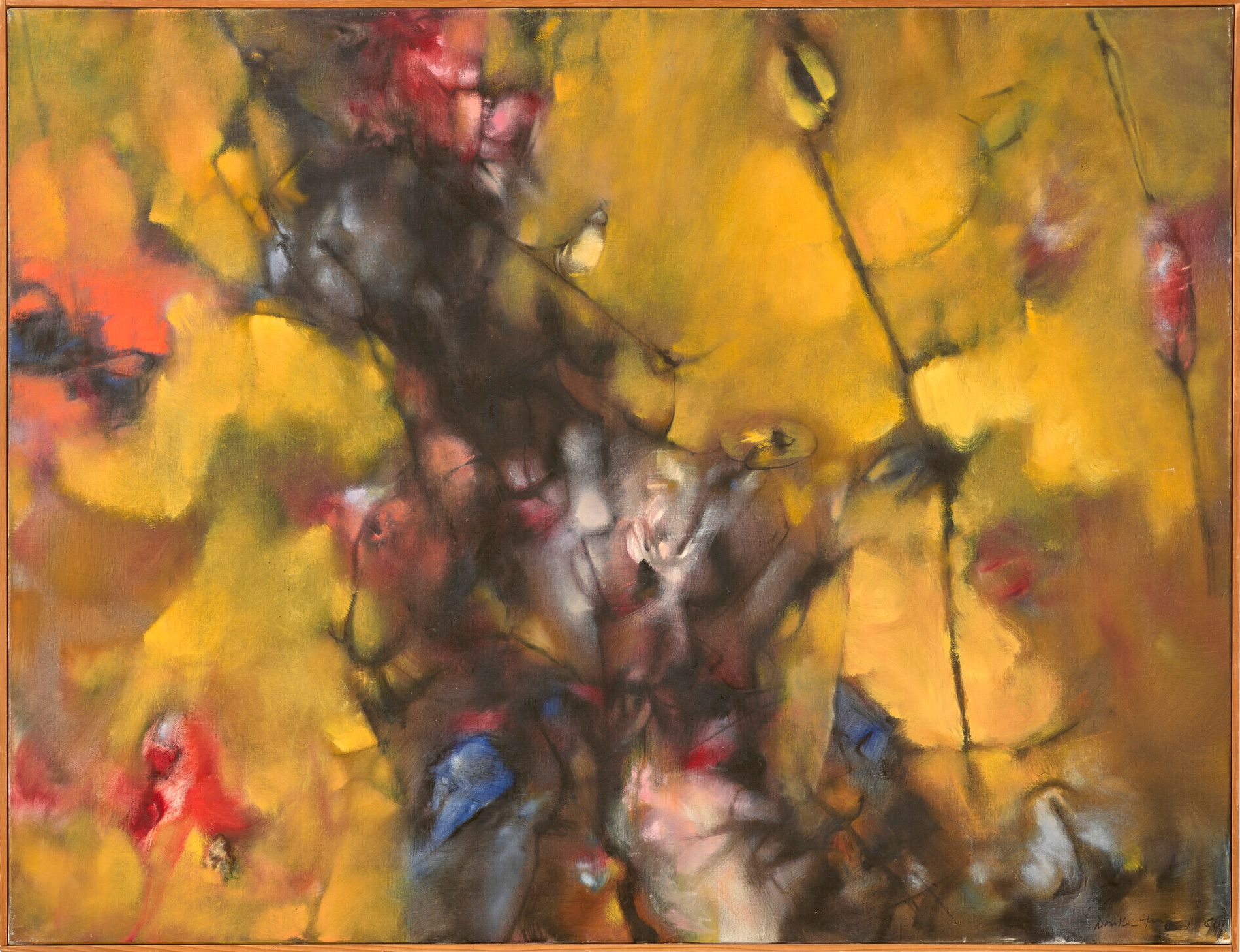Dorothea Tanning
Visite jaune (Visite éclair)
, 1960Signed and dated (lower right) ‘Dorothea Tanning 60’.
Also signed and titled (on the reverse) ‘VISITE ECLAIR DOROTHEA TANNING’.
Dorothea Tanning’s early works —paintings such as Birthday (1942, oil on canvas, 102.2 x 64.8 cm, Philadelphia Museum of Art, 125th Anniversary Acquisition, purchased with funds contributed by C.K. Williams, II, 1999) and Eine Kleine Nachtmusik (1943, oil on canvas, 40.7 x 61 cm, Tate Modern, London, purchased with assistance from the Art Fund and the American Fund for the Tate Gallery 1997)— were precise figurative renderings of dream-like situations. Tanning read many Gothic and Romantic novels from her local library in her hometown of Galesburg, Illinois. These fantastical stories, filled with imaginary imagery, heavily influenced her style and subject matter for years to come. Like other Surrealist painters, she was meticulous in her attention to details, building up surfaces with carefully muted brushstrokes. Through the late 1940s, she continued to paint depictions of unreal scenes, some of which combined erotic subjects with enigmatic symbols and desolate space.
In the early 1950s, Dorothea Tanning relocated to France with her husband Max Ernst (1891 – 1976, primary pioneer of the Dada movement and Surrealism in Europe) settling first in Paris before moving to the small hamlet of Huismes in the Loire Valley. During this decade Tanning’s approach to painting shifted dramatically, moving away from the mysterious, hyper-real scenes which had previously dominated her work to embrace a more abstract aesthetic, rooted in colour, light and movement, thus creating less explicit, and more suggestive works.
Tanning, herself, remembered: ‘Around 1955 my canvases literally splintered... I broke the mirror, you might say’. Her new direction gave birth to increasingly fragmented and prismatic works like Insomnias (1957, oil on canvas, 207 x 145 cm, Moderna Museet, Stockholm, purchase 2006 funded by The Barbro Osher Pro Suecia Foundation [The Second Museum of Our Wishes]). ‘Gradually, in looking at how many ways paint can flow onto canvas, I began to long for letting it have more freedom,’ she explained (in Between Lives: An Artist and Her World, New York, 2001):
Beginning, roughly in 1955, after a period of painting direct, simple images as statement (Tableau Vivant; The Blue Waltz; Death and the Maiden...), my painted compositions began to shift and merge in an ever intensifying complexity of planes. Colour was now a first prerogative… I wanted to lead the eye into spaces that hid, revealed, transformed all at once and where there would be some never-before-seen image, as if it had appeared with no help from me
There is a lyricism to the movement in Tanning’s canvases of this period, the fields of pigment flowing into one another with a dynamism that goes beyond the gestural act of painting, perhaps influenced by her experiences designing costumes and sets for the ballet.
In Visit jaune (Visite éclair) rich skeins of pigment fill the canvas, their cloud-like forms exhibiting an almost vaporous quality as they bleed into and across one another in subtly shifting layers. The richly variegated expanse of yellow is punctuated by pockets of soft umber, bright orange and scarlet, while at the centre a cloud of darker pigment swirls, like a chasm cutting the length of the canvas and splintering outwards. While at first seemingly formless, there appears to be an underpinning of figuration within this central section, with certain elements recalling the soft flesh of distorted or fragmented bodies, briefly glimpsed through the mist.
Provenance
Galerie Le Point Cardinal, Paris.
Mme Vernhes, Paris, by 1966.
Daniel Vernhes, Paris, by descent from the above.
Anonymous sale, Artcurial, Paris, 6 December 2016, lot 42.
Gallery Wendi Norris, San Francisco, United States of America.
An important San Francisco Bay Area collection (acquired from the above in 2019).
Christie’s, London, The Art of the Surreal Evening Sale, 28 February 2023, lot 108.
Firestorm Foundation (acquired from the above).
Exhibitions
Casino Communal, Knokke-le-Zoute, Belgium, Dorothea Tanning, June - August 1967, no. 50 (titled Visite éclair I).
Gallery Wendi Norris, San Francisco, USA (ism): 80 Years of Nonconformity, July - September 2017.
Gallery Wendi Norris, San Francisco, USA Threads of Memory: One Thousand Ways of Saying Goodbye, October - November 2017.
Literature
A. Bosquet, La peinture de Dorothea Tanning, Paris, 1966, p. 101 (illustrated).
Copyright Firestorm Foundation
